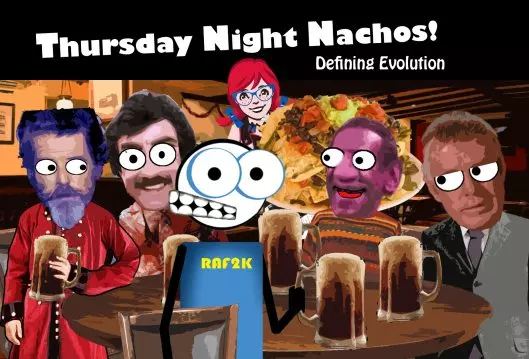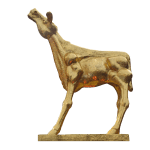The video above will sum up the key points of this chapter- in this case, the problems with several more proposed mechanisms of Evolution. The full chapter, which features Rent-A-Friend and his fellow Nacho-eating arm chair philosophers, can be read below. Enjoy! #JesusLovesYou
To read other parts of this series click here
It is the day of days! By which if course I mean, Thursday (Formerly Thor’s Day, but we’re no longer allowed to call it that without paying royalties to McDisneyBucks, very similar to THE BIG GAME which everyone refers to privately as the Bowl Which has the Properties of Superness, that being it’s name, unless they are advertising snacks for THE BIG GAME- but I digress). The reason it is the day of days is because it brings with it a pile of Nachos which reaches to the heavens! Emotionally I mean. Scientifically I think that would be impossible, but again I digress.
While our Thursdays are often full of jokes, songs, darts, pool, and movie reviews, the past several of them have started off being about an ongoing conversation which started almost as a fight. Carl and I were about to argue about whether Darwinian Evolution is or is not a fact of science, when our good friend Bill suggested we define what it is. I came up with what I feel is the world’s first clear and very useful definition of Darwinian Evolution, and for the last couple of weeks we’ve been using it to examine the claims of evolutionarily biased textbooks to see if we can determine which position, Carl’s or mine, is the correct one. If you have been reading the goings-on regularly, then I suppose that this is the paragraph you would be just as well to skip, since you know all of this already, were it not too late.
It was on this week, root beer in hand and Nachos in our near future, that Carl opened the friendly proceedings with what he felt should be accepted both as a definition for “Darwinian Evolution” as well as a mechanism of said Evolution, sure to produce the history described in the Tree of Life illustrations.
“Decent with Modification!” he said. The rest of us sat waiting for him to continue, and he looked back at us, somehow thinking he had said enough. “Decent with modification!” he said again.
“What about it?” asked Captain Blue Beard.
“It is a good definition and a very obvious mechanism of Darwinian Evolution!” said Carl.
“All right. ‘Splain,” said the Captain.
“Well, it simply means that each successive generation of plant or animal is a little different than the previous one. Over time, these little differences add up into big differences, and that’s how worms become fish, or some such thing. Decent with Modification.”
I’m not very practiced in eye rolling, but here I felt protocol required it, and so I gave it a shot. “When figuring out what is wrong with an idea,” I said, “sometimes it is merely that the idea is too fuzzy to be seen. Here in lies such a fuzz.”
“I’ve just told you what it means,” said Carl in a huff.
“You’ve said a little,” I replied, “but not enough. If by decent with modification we mean that
Evolution is an unguided, Natural process which increases the genetic information in an organism; Creating new Genes which did not previously exist.
These new genes then cause an increase in physical complexity and associated behavior, Both of which increase the organism’s ability to survive and pass on these traits to offspring,
then I agree. However, modification doesn’t really mean anything but change. If I replace a flat tire on your car, I have modified it. If I slash all four ties with a sword and pour pancake syrup into your gas tank, I have modified it. But, and I’m no car expert here, I suspect those modifications are not of equal value. A cow may give birth to a new generation of cows. Of those cows, one may be born with no eyes, and another born with five legs. These are modifications, but they are not equal. Also, these are not evolutionary changes.”
“Of course they are evolutionary changes!” bellowed Carl. “Each generation is different than the previous! How are you going to make changes as big as additions or losses of eyes and limbs without Evolution occurring?”
“Chainsaw?” suggested Captain Blue Beard.
“Not the point being made Captain,” said Bill. “Let’s consider the genetic issues. A cow may HAVE the genes for eyes, but it is not expressed. Thus, a cow with no eyes may not be genetically different than a cow with eyes, just as a baker with a cake and a baker with no cake may have the same recipe, only the first baker has actually MADE a cake and the second merely has the instructions for doing so. A cow with five legs has a corrupted gene which should have made four legs but made five instead, just as a baker who reads an order for a dozen muffins twice will make two dozen muffins. It doesn’t add any ingredients to the recipe, and its not new information. It’s an error in applying old information.”
“I don’t know,” said Tom. “I still don’t see why decent with modification wouldn’t work. Given enough time, small changes could accumulate into large ones, could they not?”
Blue Beard reached into his great red coat and pulled out his deck of poker cards. “Shuffle a deck of poker cards” he said, demonstrating for emphasis, “and you can get more than TWO MILLION different five card hands.” He dealt out a few five card piles to make his point. “But you can shuffle and deal for a billion years and you will never create a new card that way. You’ll never make the Archduke of Hearts by shuffling and dealing. Is each hand different? Sure. Is each hand very different from the original deck it was dealt from? It sure is. Does that create new cards, or explain where the cards came from in the first place? Nope.”
“So if we apply your cards to the real world,” suggested Bill, “then we have a population which has a total of fifty two alleles in the gene pool, and each member expresses five genes. This means you can have two million unique individuals, perhaps over many generations, before you must make a combination of genes which already existed in the species.”
“And in those two million generations,” said Blue Beard slapping an Ace of Spades onto his forehead, where it stuck, “you never have the creation of a new card. Every one of the two million individuals carries only the genes which existed in the original parent.”
“Just as dogs,” I interjected, “all carry genes which would have been present on the dogs aboard Noah’s Ark five thousand years ago. The hundreds of varieties of dog that exist now are just those same genes disseminated and sometimes lost.”
“Here’s an example I’m sure Carl is familiar with,” said Bill gazing into his mobile computation device. “The Finches of the Galapagos Islands, often called Darwin’s Finches. What do you know about them?”
“Well, it’s a short term study,” said Carl, “but it is a textbook example of what I am talking about. The Finches have a wide variety of different sizes of beak. Once can track the average beak size and see how it changes with the available food on the islands, which itself changes with the amount of rain in a given year. These changes are small, but given enough time will surely add up into big changes- what we call a speciation event- where in the birds will be so different that they will not all be Finches anymore. They will have evolved into new species.”
“And this is a real example?” asked Tom. “This is something we observe?”
“Something we’ve been observing,” said Carl, “for many decades now. Evolution happening before our very eyes!”
“Your brain is a marvel of modern science,” said Blue Beard, his words dripping both with sarcasm and root beer. “That you continue living while you apparently left it at home is the marvel. First, you haven’t given us evolution happening before anyone’s eyes, you’ve given us your faith that SOMEDAY evolution will happen.”
“It’s decent with modification!” replied Carl brashly. “We have been tracking the kind of changes that will add up into the big changes your tree of life requires!”
“That so?” asked Blue Beard rhetorically. “Hey Bill, what does your research say about the cumulative changes in these magical birds?”
“Cumulative changes?” asked Bill.
“Yeah. How much have their beaks changed since Darwin was there his self.”
“Well, there is no cumulative changes,” said Bill. “There are variations with the different seasons, but then the populations change back when the weather changes again.”
“So, let me get the details right,” said Blue Beard with a glint in his eye. “We have, when Charlie D was there a hundred some years ago, Finches with big beaks and little beaks. Right?”
“That’s right.”
“And today we have Finches with big beaks and little beaks, right?”
“Yes, that’s right.”
“And these changes in the population we see are an increase in one of those varieties, depending on a change of environment, which swings the other way when the environment swings the other way. Isn’t that right?”
“Yes, yes?” said Carl. “And what is your point, Blue Beard?”
“My point, you half wit,” said Blue Beard, “is that this is no different than your stupid Peppered Moth example! You got two variety of something. One is more popular, and then the other is, and then the first one is again. Nothing gained. Nothing lost. Nothing EVOLVED you barnacle encrusted goober!”
“What do you mean?” replied Carl, his face getting red. “Of course they evolved! There was decent with modification! Each generation is different than the one before!”
“Blue Beard is right, Carl,” I said. “Just like the Peppered Moths, this is merely an exercise in tracking the more popular variety, but this will never create a new variety. What we’ve learned by tracking these birds is that they all interbreed, making them one species, and the changes in generations don’t add up across time. They merely oscillate. There never will be a speciation event according to the data we have. This, once again, is why Decent with Modification fails both as a definition and as a mechanism of Darwinian Evolution.”
“But there are a lot more examples,” offered Tom. “What about SUPER BUGS? Those bacteria which resist antibiotics?”
“Those result from a loss of genes,” I answered. “The bacteria which aren’t killed by antibiotics are lacking the ability to make an enzyme, or the ability to bring the chemical into the bacteria. It’s like having a house with doors that refuse to open. When the postman is delivering bombs, you survive because you couldn’t open the door to get yours. But your house hasn’t gained a new feature, it’s lost the use of a previous one. This is the exact opposite of evolution. And besides that, those variations on the bacterial species have existed since long before antibiotics did. So when people talk about them evolving, they are either using the “Changes in allele frequency” definition, because the percentages in the populations change, or they are implying their faith that somewhere in the distant, unobserved past, they MUST have evolved because there they are.”
“What about Nylonaise?” said Carl. “That bacteria which can digest nylon when previous bacteria could not? Surely that is an example of evolution in action!”
“I’m not familiar with that germ,” I admitted. “Bill, what do you know?”
“Nylonaise is a bacteria which seems to have developed the ability to digest nylon, which is something previous generations of bacteria couldn’t do.”
“There!” said Carl triumphantly. “You see? Evolution in action!”
“Sorry Carl,” said Bill. “Those result from duplication of previously existing genes, NOT from the creation of a gene which did not exist. To follow the previous metaphor, this is like the builders making your house with two front doors when the original blue print only called for one. It’s a duplication of something which already existed. It means you can take in twice as many delivered pizzas.”
“It’s still a new feature created by a genetic change!” said Carl. “Even by his definition, that is evolution!”
“My definition,” I explained, “calls for the creation of new genes which did not previously exist. You will never get a new gene by duplicating an already existing gene.”
“Just as you won’t get a house,” said Blue Beard, “by installing more doors than was called for.”
“What about Poodles,” asked Tom, “and Chihuahuas and other dogs which didn’t exist until recently? Aren’t there new genes somewhere in all of those hundreds of varieties of dog which we know did not exist until recently?”
“Those dogs,” I replied, “in fact, all 400 varieties of dog, are the result of shuffling and losing of genes from an ancestral wolf population. Never do we see NEW genes for NEW features and behaviors.”
“This is one of the reasons,” added Bill, “Pure Breeds are riddled with problems. They didn’t develop new features, they lost old ones. Poodles can’t shed, which means they can easily overheat. Poodles are a genetic nightmare.”
“Besides that,” said Blue Beard, “all of them dogs were bred by persons with some goal in mind. Dogs for hunting, dogs for guarding, dogs for being used as throw pillas or accessories in oversized purses. None of them were made by natural processes. So this, again, tells us about the diversity existing in the dog kind, but not about what biology would do left to herself.”
“So, what are we saying about Decent with Modification?” asked Bill.
“It’s no different than Change over Time,” I said. “Merely because of the fuzzy nature of it, I am saying that Decent with Modification is NOT evolution, and for the same reasons I will say “Putting metal parts together” is not synonymous with “Auto Manufacturing.” If you have a problem with that, you can do something with it, and put it in a place.”
“Well, my place is about to be full of Nachos!” exclaimed Blue Beard, making note of the approach of Wendy behind our pile of dinner.
“By ‘place,’ I hope you mean your mouth,” said Bill.
“I hope so too, lad!” And Blue Beard laughed loud and long, until Nachos were shoved into his place.
While the night would be full of games and laughter, I could tell by the look in Carl’s eyes that the conversation was not over. Another Thursday would meet us soon.
Until then, Happy Nachos! And thanks for letting me be your Rent-A-Friend.







